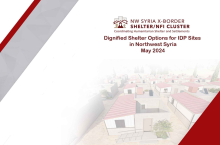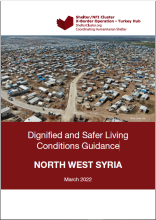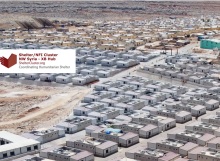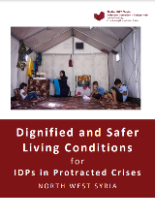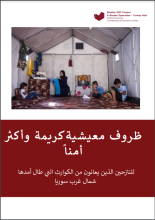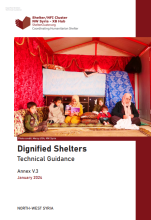North-West Syria Hub
Dignified and Safer Living Conditions
After a decade of conflict, the shelter sector in Syria needs to reflect a range of humanitarian shelter options that provide safety, dignity and protection in a context of protracted displacement. These options should also support the choices made by IDPs themselves in finding adequate shelter. Adequate humanitarian shelter options can vary according to the needs, urgency and circumstances of the IDPs themselves.
Dignified and safer living conditions are not only relevant to the shelter response, they are vital protection actions, especially considering that IDP sites in NWS are made up of mainly women (22%) and children (58%).
It is crucial to acknowledge that shelter is a process. Families may move between the options that are outlined here as their circumstances change. Within this range of options, it is important to consider both immediate life-saving shelter needs as well as Temporary Dignified Shelters that can have a longer life span and afford greater levels of protection.
Guidance Documents
This technical annex outlines the key elements and standards to be considered when designing, rehabilitating or installing shelters at IDP sites in NW Syria. This technical guidance can be utilized to develop shelter solutions in accordance with these parameters. The guidance also provides a number of case studies of designs which have been piloted in NW Syria. The information provided should be used to inform the development of future shelter response activities.
The Dignified and Safer Living Conditions guidance addresses the complex, inter-sectoral challenges of protracted displacement and the need to provide dignified shelter and living conditions to those living in IDP site through:
1. Upgrading of IDP sites to transition IDPs living in tents and other inadequate living conditions to dignified shelters.
2. Promoting integrated multi-sector site planning including drainage, sewage, water, roads, lighting, electricity, early recovery and livelihoods, education and health.
3. Ensuring that affected people are central to all planning and advocacy efforts.
The action plan outlines how to transition IDPs living in tents to dignified shelters that are better suited to protracted displacement and promotes integrated multi-sector site planning.
The Conceptual Framework documents and endorses the need for a range of shelter options that are appropriate to a range of shelter needs. These include immediate, life-saving interventions as well as humanitarian shelter solutions that reflect situations of protracted displacement and build on the choices that are already being made by IDPs themselves.
The Conceptual Framework on Dignified and Safer Living Conditions for IDPs in Protracted Crises has been translated into Arabic with the aim of making it more widely accessible.
As of June 2023, there were 1.97 million IDPs living in in 1,531 IDP sites in NW Syria, %46 of households in IDP sites are living in tents while %44 of those need their tents replaced.
The guidance in this document is to promote dignified shelters for those in need of temporary support.
The Technical Working Group for Dignified Shelters has drawn on earlier work including the Dignified and Safer Living Condition Guidance and examples from tested designs and materials which have been piloted in NW Syria. Beyond survival, shelter is an essential contributor to security, personal safety, protection from the climate and resistance to ill health and disease. Ensuring adequate dignified shelter provides households with a place from which they can address their other needs, promoting the use of existing capacities and resources.

